Supermicro E300-9D-4CN8TP Internal Overview
To access the system, we first remove two screws that allow us to then remove the top cover. Inside, we are greeted with what appears to be yet another cover. The holes on this interior cover are designed so that one can attach a 2.5″ SSD using screws to this cover and mount it in the chassis. While not the most elegant solution, it works.
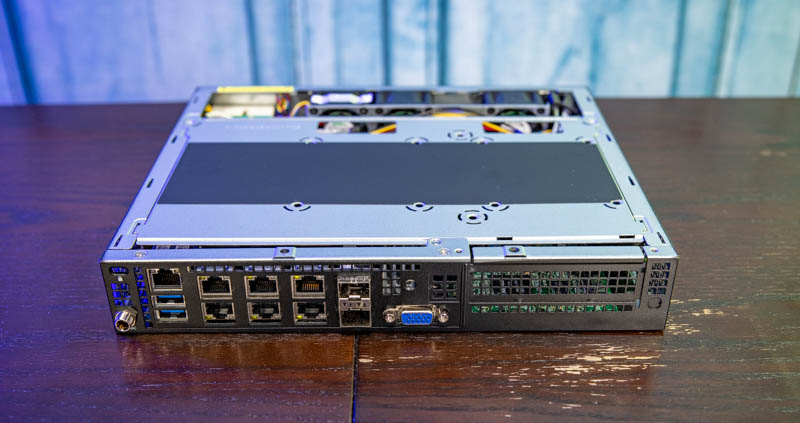
Removing this internal cover requires removing three more screws. Underneath, we get to the main system area.
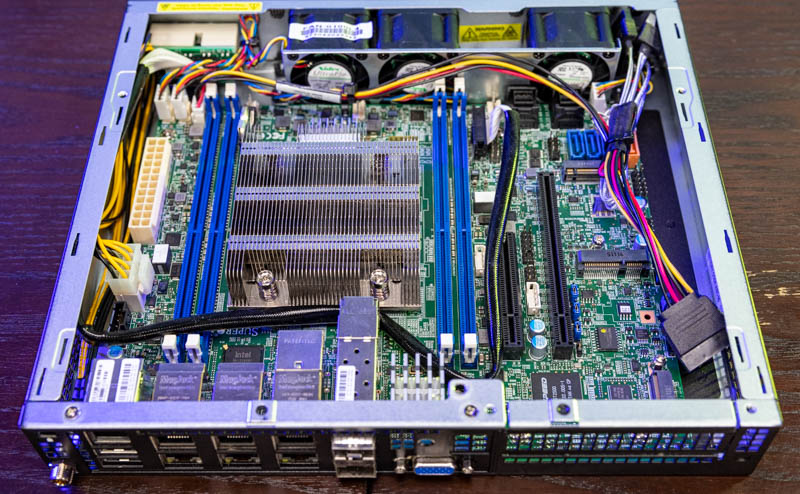
Here we find the Supermicro X11SDV-4C-TP8F motherboard as the key feature. There is only a modest amount of room in front of the motherboard for the fan tray and front I/O panel electronics. Here there are three fans that move air through the system. These are mounted on a removable bar that one can remove from the chassis (without screws) to then access the three fans. This is not as easy as server hot-swap fans since the fans screw into the metal fan bar, but it is much easier than trying to screw fans directly into the chassis.
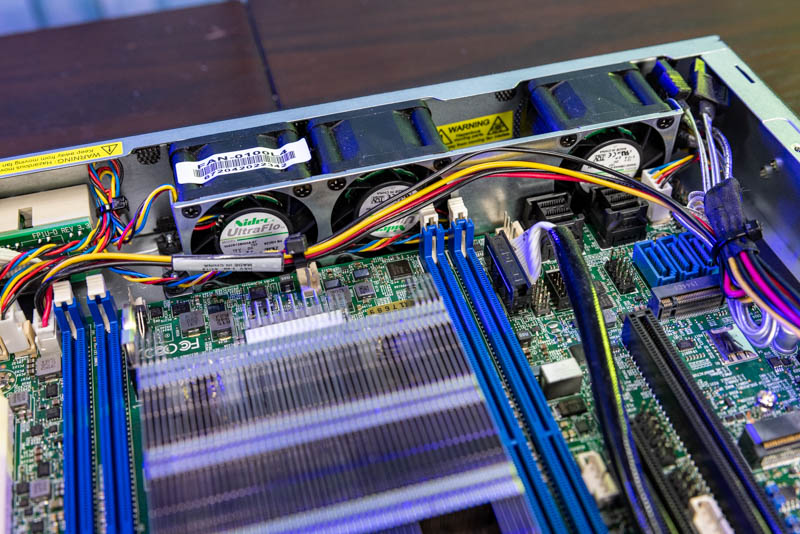
The system itself is powered by the external DC power supply which means we only use the 8-pin connector and not the ATX power input. There is a small power port that sits below the top two fan headers that provide power to drives that may be attached to the top cover.
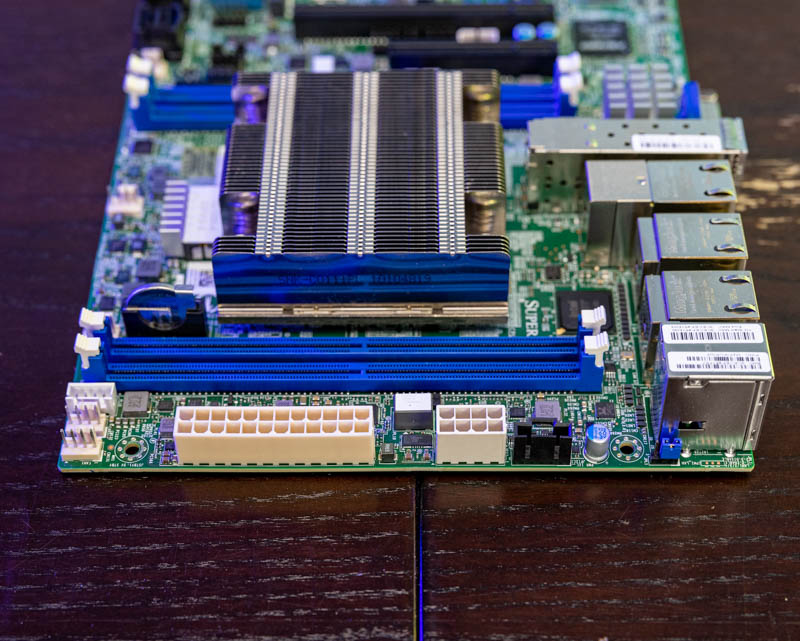
Onboard we have an Intel Xeon D-2123IT. This is a 4 core/ 8 thread SoC that operates at up to 60W TDP. One item we should note is that these CPUs generally use more power than the Xeon D-1500 processors, but they have a very nice feature. The cores are Skylake like the first generation Intel Xeon Scalable parts, and the I/O is effectively handled by the same IP found in the Lewisburg PCH found on first and second-generation Intel Xeon Scalable systems. Given this is effectively the mainstream platform for Intel from 2017 to 2021 (and the Lewisburg Refresh for the Cooper/ Ice platform has some of the same IP) that means this platform has excellent software support at this point.
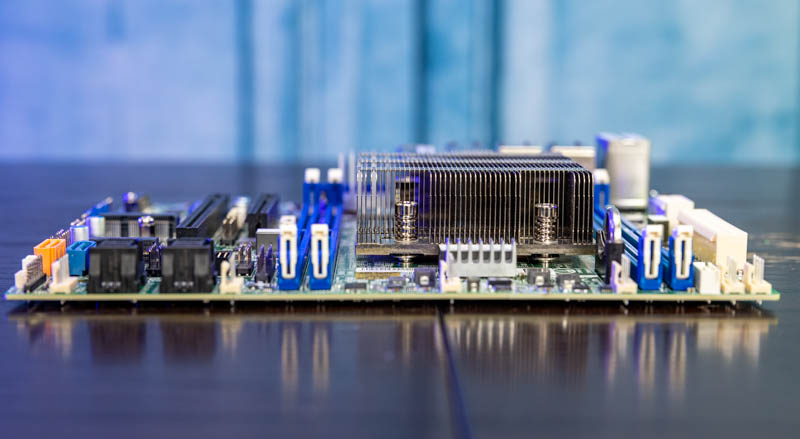
Flanking the Xeon D-2123IT we have four DDR4 DIMM slots. One can populate up to 4x 128GB LRDIMMs in the platform for 512GB of memory. This also means we get more memory bandwidth and more memory bandwidth per core than the dual-channel 4-core/ 8 core AMD EPYC 3000 parts such as the AMD EPYC 3151 and EPYC 3201.
In terms of expansion, we get a PCIe 3.0 x16 and x8 slot for standard expansion slots. Given the small form factor, the x8 slot is used for the PCIe riser and is effectively the only one that can be used in this system, and only if the riser is installed. Otherwise, this system is designed for less traditional PCIe expansion than some larger servers.
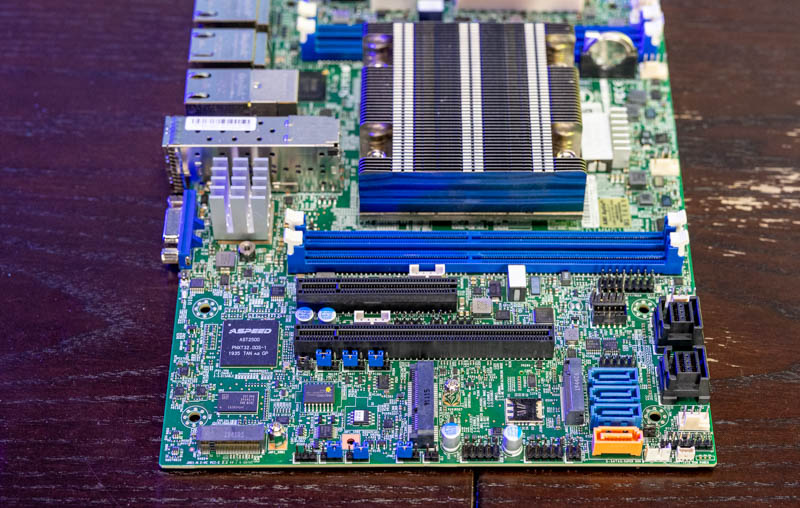
On the motherboard, we also get a mPCIe slot, a M.2 2280 (PCIe 3.0 x4), and a M.2 B-key slot for wireless WAN connectivity. There is even a SIM card slot under the B-Key 3042 slot.
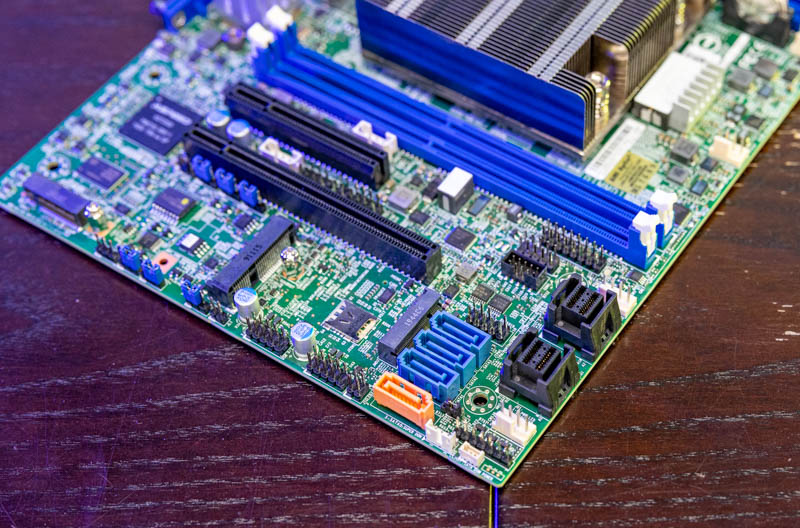
For SATA SSD connectivity, there are four onboard standard 7-pin SATA ports. One of these ports is a SATADOM port that can power a SATADOM without a cable. It also has two high-density ports which can each break out into four additional SATA ports for twelve total. In a chassis like this, one is unlikely to need even four SATA ports given the size of the system.
Internal cable management is a bit tricky given the small chassis. Just as a note, this system has been used and even installed into a new E300 chassis so the cabling is unlikely to be just as it would be from the factory.
Next, we are going to get into the block diagram, management, performance, and our final words.




Thank You for your solid review of my dream motherboard! Yes, I am one of those Supermicro X11SDV-4C-TP8F fanboys;). Best Regards, ABQ :)
I know as the readers of STH we do not like that STH is now doing video, but the video for this one is like a doctoral dissertation on this system and the current state of the Xeon D-2100 series.
I’d say you should make the Xeon D insight around pricing from the video its own article. That’s a stinger in the video.
Anyone that has one and can comment on how picky this system is regarding SFP+ optics/DAC? I have the previous generation and with most Intel drivers these started requiring Intel coded DACs halfway through their lifecycle, causing major issues when this happened after scheduled updates on devices in the field.
Intel forgot to put a QAT in this processor :)
Not great for IPSEC, openssl and crypto workloads.
VPNs are quite popular in 2021.
But they offer nice xeon-d models with hardware crypto acceleration.
The Supermicro SuperServer E300-9D-8CN8TP has some distinct advantages. The E300-9D-8CN8TP sports an Intel® Xeon® D-2146NT, which has Intel Quick Assist Technology. The reviewed Supermicro SuperServer E300-9D-4CN8TP sports the more limited Intel® Xeon® D-2123IT, which lacks Intel QAT. The E300-9D-8CN8TP adds 4C and a sizeable $500 on Amazon. An alternative might be to add an Intel QAT accelerator, but there would need to be available power and you’d lose the PCIe slot. Used Intel QAT accelerators are available on eBay for cheap.
it’s seems a great option for home server but for 8-900 $ it’s to high
The Supermicro X11SDV-4C-TP8F motherboards are $449 NIB & free shipping, if you already have a case.
@Fred Tang: I am a long-time reader too and enjoy the videos.. So it is not all of us.
I was sceptic at first, but it provides additional value and is not just the article script in video form.
I urge other video sceptics to give it a try!
And to the die-hard anti-video crowd: Any tech journalist knows, that without YouTube, traditional online journalism is dead as disco. It is a matter of survival, plain and simple.
@ABQ Supermicro X11SDV-4C-TP8F in italy is over 700€ on ebay 500$ plus 2-300$ of duties
usa’s price is very differente for europeans people for costums duties and VAT (in italy is 22%)
BMC/IPMI licenses are BS, which is why I’m happy purchasing Gigabyte/ASrock Rack.
I’m running 2 of these for 2 Years 7/24 now without any Problems. Perfect for a VMWARE Home-Lab, but not only. I’ve replaced the (loud) Stock Fan’s with Noctua Fan’s – they are not so loud and cools good (Noctua NF-A4x20 PWM). Also added the RSC-RR1U-E8 expansion for the low Profile Riser Card (AOC-SLG3-2M2-O), so you can run 2 additional M.2 NVMe SSDs. Perfect for running/testing VSAN (Robo). As i was so satisfied with this Supermicro-Solution i run now 2 additional 8-Core Versions of this Barebones (E300-9D-8CN8TP) for running/testing “remote-site replication” scenarios. I can only recommend this Barebones.
Hi Giuse! Did you replace the fans of the E300 chassis with Noctua fans? Are you happy with them? Did it get silent?
Hi Giuse! greeting,
do you run E300-9D-4CN8TP or E300-9D-8CN8TP,
I’m looking for my expansion of 2x for workload home lab (VMware SDDC Stack) on E300-9D-8CN8TP?
do you advice for the same.
SYS-E300-9D-8CN8TP
Release Date: Nov 2018 (EOL: Q1 2025)
CPU: Intel Xeon D-2146NT (8c/16t)
Memory: 512GB
Storage: 1 x M.2 (Additional 1 x M.2 possible with PCIe Add-in-Card or 2 x M.2 possible with AOC-SLG3-2M2)
Max Devices: 3
Network: 2 x 10GbE, 2 x 10GbE (SFP+), 4 x 1GbE, 1 x 1GbE (IPMI)
VMware HCL: Yes (supports up to vSphere 7.0 Update 1)
which one you recommend:
1-https://www.amazon.com/gp/product/B07JN5T2RT/ref=ox_sc_saved_title_6?smid=AEELF2HAVZFED&psc=1
2-https://www.amazon.com/gp/product/B07RCN114X/ref=ox_sc_saved_title_5?smid=ATVPDKIKX0DER&psc=1